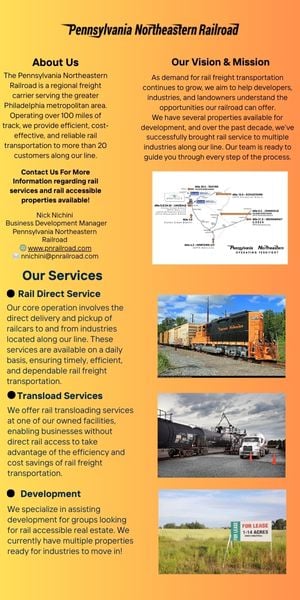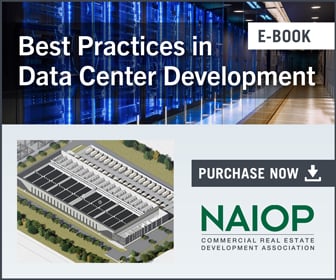From Horizontal to Vertical: Industrial Intensification Grows Up

Multistory industrial facilities illustrate innovative strategies for areas with a constrained supply of land.
As e-commerce and technology push industries to evolve, businesses are placing greater importance on integrated work spaces. These are places where design, manufacturing, distribution and showroom activities occur within a single building.
At the same time, companies must deal with land supply constraints, increases in space demand, and economic and population growth. These trends are driving new opportunities for industrial lands intensification, such as multilevel developments (sometimes referred to as “vertical” or “stacked”), while challenging old planning regulations.
Industrial properties are no longer single-story buildings located on the urban fringe. New forms of industrial intensification provide more space for companies to expand and boost employment growth within communities.
What is Industrial Intensification?
“Intensification” refers to increased use of, or greater productivity within, industrial properties. It can range from higher ceilings with racking in distribution centers, to more shift workers, to investments in automation, or multilevel buildings in urban locations.
There are two ways to think about industrial land use:
Intensity is the amount of activity. It is measured as jobs per building or land area, or the volume of goods produced or processed per unit.
Density is the amount of building. It is measured as floor area ratio, site coverage or building heights/volumes.
Higher intensities are associated with higher densities, but this is not always the case. Exceptions are land-intensive industrial uses with high throughput activity that don’t require a large building, such as a lumber mill. These activities need land for truck loading, vehicle parking, and outdoor storage of equipment and materials.
Drivers and Benefits of Intensification
In East Asia, multistory industrial buildings are common. Because of a lack of affordable land, companies have had to build up to fulfill their space needs.
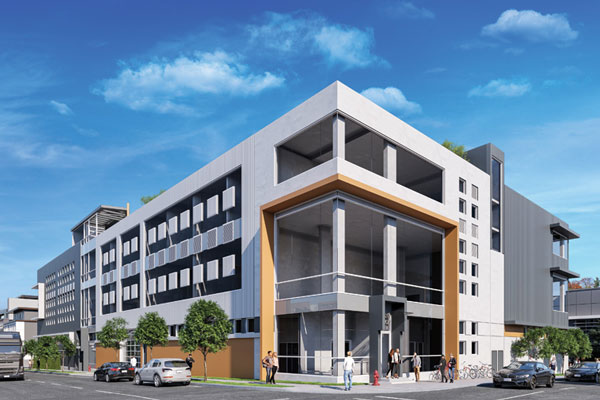
IntraUrban Evolution in Vancouver provides 105,000 square feet of industrial and office space across four levels.
In North America, there are relatively few multilevel industrial buildings. However, more are being built, with notable new projects in Vancouver, Seattle, San Francisco and New York — all places with very high land values.
Consider Metro Vancouver, which has a population of 2.5 million and is home to the largest port in Canada. There is a severe shortage of industrial land in the region. This manifests itself in various ways — rising land prices, very low vacancy rates and rental rates that are among the highest in North America. According to a report from Colliers International for the third quarter of 2019, the industrial vacancy rate in Vancouver was below 2% for the 10th consecutive quarter. The current average asking triple net rent has increased 25% from two years ago. These supply-and-demand forces are spurring intense and dense forms of industrial development, such as multilevel buildings.
Industrial intensification promises many potential benefits for both industry and the community, especially in jurisdictions with a constrained land base:
- More efficient use of resources, reduced development pressures on lands in the region and possible conversions, such as from agricultural to industrial.
- Building multilevel properties creates more industrial space and capacity as land for industrial
use becomes increasingly difficult to find. - Clustering or co-locating related operations can support eco-industrial networks and circular-economy systems. In these innovative complexes, companies collaborate to use each other’s by-products (material loops) and share resources (peer-to-peer lending) to increase efficiencies.
Evolving Types of Industrial and Accessory Uses
Industrial activities are evolving and becoming more diverse. Some have more accessory uses, which require new and different types of spaces.
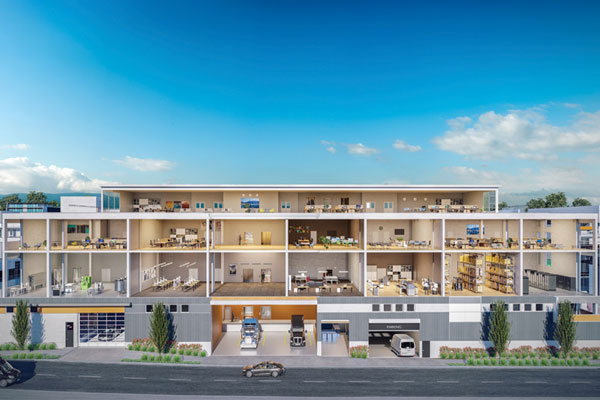
An internal view of IntraUrban Evolution shows areas for warehousing and office uses.
Many new commercial activities do not fit neatly within the traditional concept of “heavy” or “light” industrial. These can range from conventional distribution, warehousing and manufacturing in large single-user buildings to small-scale operations such as parts suppliers, food processing, equipment maintenance, workshops, laboratories, local “maker movement” craftsmanship, fabrication/assembly in industrial flex space units, as well as emerging e-commerce, advanced technology and creative/media/design.
Industrial areas can contain accessory and commercial activities that support or are related to the primary industrial use. These areas can also provide amenities for local employees. However, allowing too much additional office or retail space could destabilize or displace established industrial uses by raising land costs, property taxes and rents, and introducing land-use conflicts.
The Challenges of Building Up
Compared to conventional single-level structures, multilevel industrial buildings are much more complex to design and more expensive to construct. For example, they often require underground parking facilities, as well as access stairs and elevators. Functional building features for industrial tenants include loading bays; cargo elevators or truck ramps; specific corridor widths; specific requirements for ceiling heights and column spacing; and floors with load-bearing capacity.
Multilevel buildings and structured parking facilities introduce inefficiencies that reduce net usable areas. In addition to stairs, elevators and hallways, they prominently feature vehicle ramps, which are not used in conventional single-level industrial buildings with surface parking.
These extra costs require higher rents for projects to be financially viable. In some cases, this means new higher-density industrial developments. These may include accessory or commercial uses that are related to the main industrial tenant, which can help cross-subsidize the cost of the building. In Canada, new multilevel industrial projects are often associated with stratification (condominium) tenure, with units that are owned rather than leased. Pre-sales of units help finance these developments.
In other cases, density is limited by regulatory and functional requirements for parking, loading and setbacks.
Considerations for Municipal Plans and Policies
Multilevel industrial development follows international trends toward intensification and densification, and it generates much-needed industrial capacity. Industrial intensification offers community benefits such as jobs, economic growth and a higher tax base.
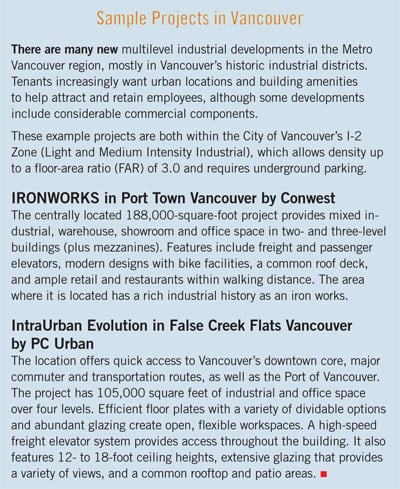
More North American cities recognize the evolving nature of business, and they’re adopting industrial, economic and employment strategies that advance new opportunities and remove barriers. A primary policy consideration is how regulations should permit these types of new industries and business models. Municipalities should recognize these new industrial forms while not discarding established uses.
To boost industrial development, municipalities should work to remove outdated barriers to densification/intensification by considering the following when reviewing land-use policies:
Permitted industrial uses. Add new industrial uses that may not appear in existing industrial zoning bylaws, such as e-commerce, last-mile delivery and integrated work spaces.
Non-industrial uses. Restrict non-industrial uses to an accessory scale that supports the primary industrial functions.
Density limits. Adjust density caps such as building setbacks and height limits, as well as floor area ratio and site coverage maximums.
Parking requirements. Reduce minimum parking in urban locations and areas located near mass-transit options.
Some government agencies worry that newly constructed buildings will not be used for their intended purposes. To secure the industrial use of the premise beyond zoning use definitions, municipalities should enforce occupancy permitting and business licensing.
Future Considerations
Industrial development is an important part of a regional economy. While some uses will continue to be land-intensive, new forms may reside in multilevel buildings. Municipal plans and regulations should guide market forces in ways that respond to industrial needs while considering other community objectives. The complexity lies in balancing industrial trends, development viability, business needs, responsive regulations, and other community interests moving forward.
The challenge and opportunity is how to intensify industrial uses without losing the industrial function of the lands.
Eric Aderneck, RPP, MCIP, is industrial lands planning consultant. He can be reached at eric@aderneck.ca. His website, www.MVindustriallands.com, includes resources about industrial lands planning and development matters.
NAIOP Vancouver Gets InvolvedWith a limited land base and the need to coordinate planning, the Metro Vancouver planning authority is preparing a regional industrial lands strategy to address these issues and explore policy options and actions, including industrial intensification. NAIOP Vancouver has an Intensive Use of Industrial Lands Committee that is exploring how to promote intensification. The organization recognizes three different types: multilevel logistics/manufacturing; multilevel urban industrial; and multilevel urban industrial with rental housing. As part of that initiative, NAIOP Vancouver organized a panel event in June 2019 to discuss the trends affecting industrial lands utilization and the potential for intensification. Here are the key areas of focus for NAIOP Vancouver:
To learn more, visit: www.naiopvcr.com |


